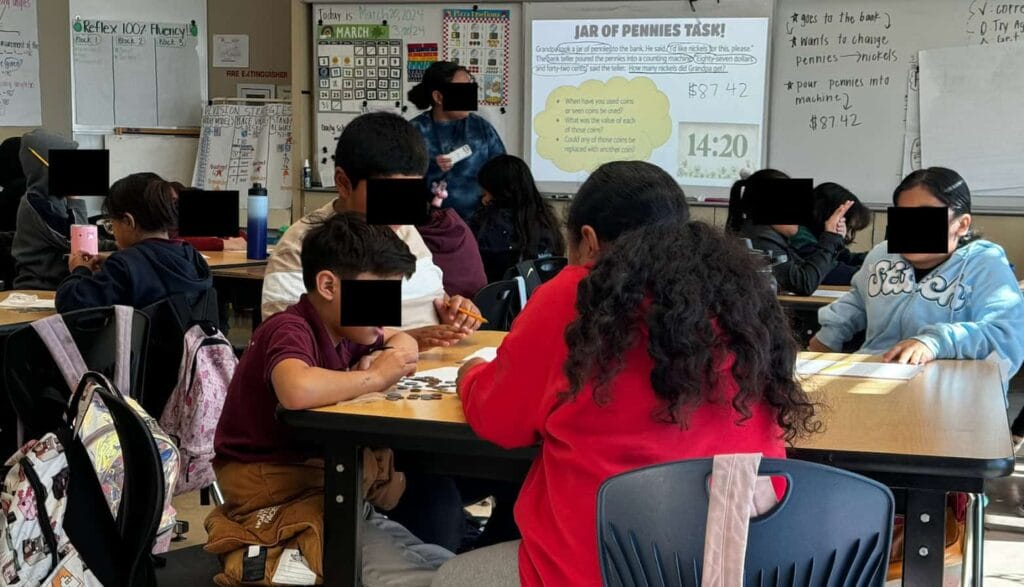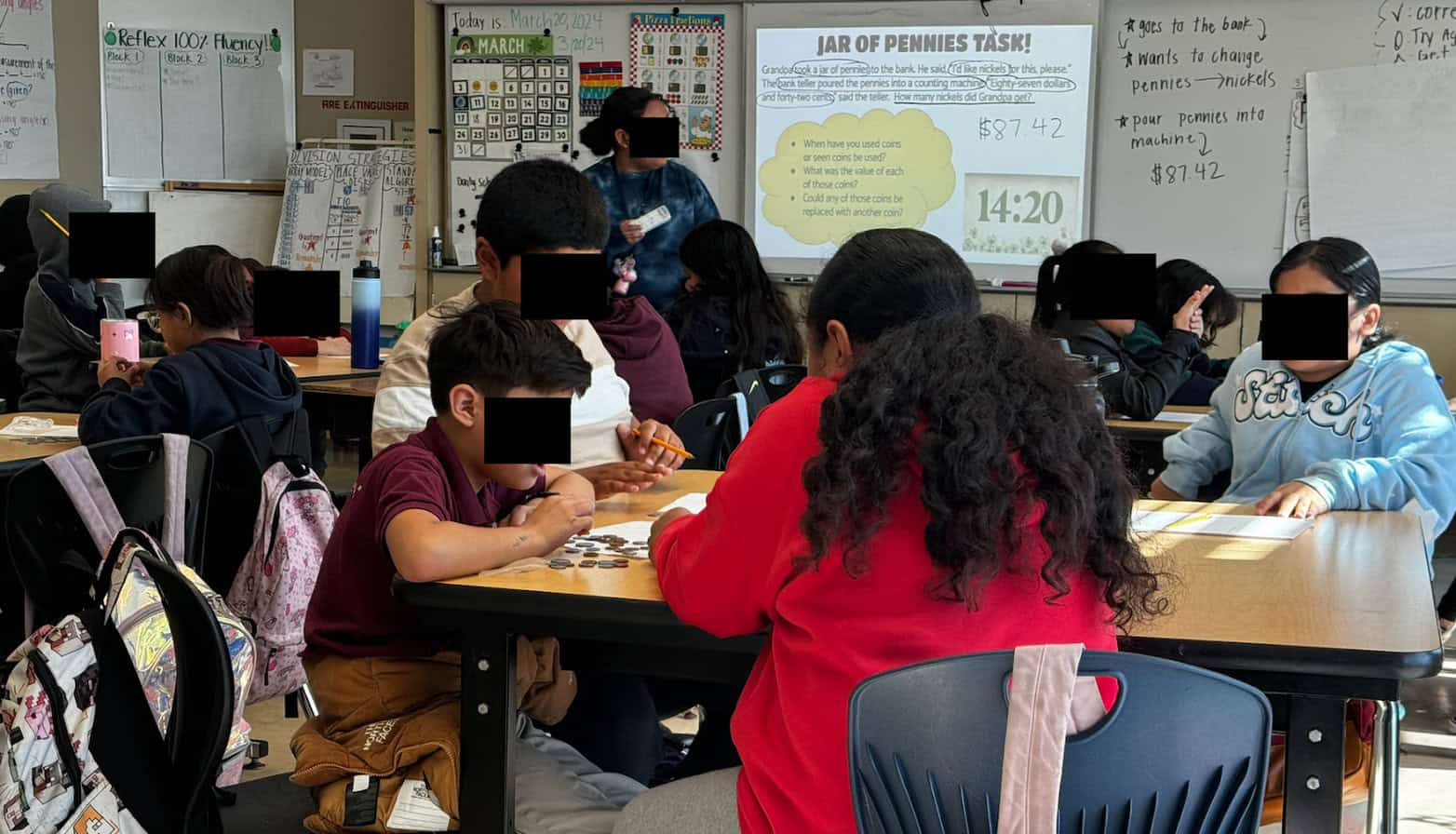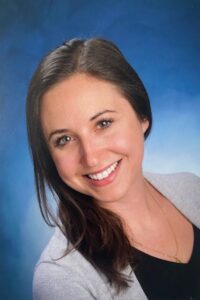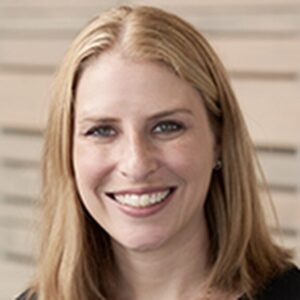Building student capacity to think critically and independently in order to make meaning of and solve complex math problems is at the core of students building true conceptual understanding and application-based skills to connect math to the real world. At Education for Change Public Schools, we have continuously seen our students work hard, ask and answer brilliant questions, and grow in their journey as math learners. We have also experienced our students struggling with feeling confident when asked to engage with complex math word problems and tasks. Naomi Perl, Director of Math, observes students doing their best to solve the problems and tasks but momentum often ends quickly. The challenge is often met with “students waiting to be told what to do for their next step or they just wait for the teacher to write down the answer.” Building our students’ confidence and acknowledging the strengths and skills they already bring to the problem are part of a puzzle for which we have struggled to find the missing piece.
When the opportunity was presented to partner with Student Achievement Partners through Math Milestones™, we were eager and excited to see how the partnership might help our students with not only solving rich math problems but also with increasing their ownership of the thinking and learning that happens when engaging with rigorous grade-level tasks. We also were excited to provide tools and training to our teachers on how to shift practices to allow more opportunity for student thinking in the classroom.
Education for Change Public Schools
Education for Change (EFC) is a public charter school system in Oakland, California. We operate as six schools and serve over 2,700 students ranging from TK-8. Our mission at EFC is for “students to challenge the predictable patterns of performance and access to opportunity in this country by demonstrating the essential academic competencies, personal agency, and integrated identity necessary to be prepared for a meaningful and productive life.” Through this mission, we are dedicated as math educators to continuously engage students with grade-level standards, build our classrooms and adapt our curriculum around culturally relevant learning, and encourage our students to see how what they are learning connects to the world around them beyond the classroom.
Need for More Ownership in Students Doing the Thinking
Over the last seven years at EFC, we have successfully implemented a standards-aligned curriculum, Eureka Math, across all sites and grades at our six schools. However, when engaging students in complex word problems within the curriculum and looking at assessment data over time, we realized that our students are not always making the accelerated growth we anticipate. Precious James, Instructional Coach at Learning Without Limits said, “As an instructional coach, I have noticed the disparity in the amount of talking and thinking the teachers are doing and sometimes how little the students are actually doing.” One challenge we are facing as teachers is that not only do students struggle to independently think about and then attack complex math problems without teacher support, but also we must be mindful of the opportunities we are creating for students to engage and build critical thinking skills without our support. Lizbeth Garcia, 4th grade teacher at Learning Without Limits said, “In class, a lot of times I notice that students are trying to recall or remember a strategy and connect that strategy to the problem instead of making meaning of the problem first. They actually do have a lot of knowledge and skills to be able to answer the problem, but there isn’t a pause in their thinking to make sense of the question first and then use their thinking to work through the multiple steps.”
This year, we implemented a word problem protocol, Math Story Problems, in all our math classrooms with the hope that it would support our students in solving tasks and complex word problems. During these 20-30 minutes, we focused on visualizing, representing, discussing, and sharing out what students did and how they solved the problem. Through this protocol, we did see an increase in students attempting to put their thinking on paper through representations. However, many students were still guessing how to best solve the problem instead of taking their time to understand what the problem was asking. Kristina Hargreaves, Instructional Coach at Cox, said, “The progression of learning for the class is sometimes missing. The conversations need to focus on how to get students to take what they did today and think bigger about it so they can apply it the next time with a deeper undertsanding.” The discussions at the end of the protocol also centered around the students who already knew how to solve and were able to get to the right answer.
Using Math Milestones™
After learning about the resources, alignment, and mission of Math Milestones™, we decided this would be a strong partnership to support what we felt was missing in our math classrooms. We also recognized that many of our systems and structures would allow for Math Milestones™ tasks to be embedded seamlessly into our intended problem-solving part of the math block. Teachers have designated collaborative planning time with their coaches and grade-level partners weekly, and also attend bi-weekly math professional development. In addition, all teachers have the support of a coach they meet with once a week. We were confident these structures already in place would allow a seamless transition to a space for teachers to reflect on their current teaching practices, learn new methods and strategies for building critical thinking skills, and support students in recognizing the assets they already bring to the math classroom.
EFC’s partnership with Student Achievement Partners (SAP) was a train-the-trainer model. Two EFC math instructional coaches and the Director of Math participated in the SAP-facilitated training and then brought back the learning to train four of the teachers selected to participate and use the Math Milestones™ protocol and resources with their 4th-grade students.
Through this training, leaders were able to more deeply understand the need for, the purpose, and the process of using Math Milestones™, while teachers were able to plan more deeply how they would facilitate a task with the class that would lead to rich and meaningful discussions stemming from students feeling confident about accessing and solving the task. Both leaders and teachers were able to walk away with a better understanding about the importance of launching a task with the class to provide access points to the learning, and how what we say and how we respond to the work students show can propel them forward in their thinking and beyond the steps to just get to the answer. SAP’s flexibility and adaptability to support the use of Math Milestones™ in our schools was key to gaining teacher buy-in and overall investment in the partnership and process.

Putting it into Practice
Teachers spent several sessions learning how to use and plan with the Math Milestones™ resources. Kristina Hargreaves said, “Teachers enjoyed seeing the Math Milestones™ connected to grade-level standards on a one-page grid to discover and examine the progressions and connectedness of grade-level mathematics. Too often, mathematical concepts are taught in isolation, and that harms the coherent and focused nature of deep learning and being a mathematician. Math Milestones™ remediates that type of teaching and learning.” Teachers expressed how the intentionality behind the sequence of student learning helped them to understand the math deeply and to create a clear goal for the task that supported driving the lesson and the thinking they wanted students to do.
Launching the task with students and enhancing the mathematical thinking and learning they already possess before even looking at the task allowed for every student to feel confident in accessing the task. Bre Bolerjack, 4th grade teacher at Cox Academy said, “The part I like the best is being able to think about and plan for how to build on what students already know about math in the real world and give them a chance to connect that to the problem we are solving.” As students worked through the tasks, it was evident that teachers had made a shift from prompting students what to do next to engaging them in sharing their thoughts and thinking about the next steps. Kristina and Precious agreed that through this protocol, “We saw more students taking risks in their representations and when explaining their thinking to peers.” The launch and strategic prompting provided more ownership as students took on the heavy lifting and also forced teachers to really listen, see, and honor the diversity of student methods in solving.
During the discourse, students were excited to see their thinking made public, and it was exceptional to hear students make sense of their peer’s work in a way that was constructive and deepened their thinking. Students valued each other’s thinking throughout the launch and during the discourse, and more students were able to make sense of their own work even if the discussion was not centered around their specific strategy. Engagement and participation were much stronger because students wanted to learn from each other and build on each other’s thinking.

Impact on Student Confidence and Thinking
Math Milestones™ provides an opportunity to give students standards-aligned problems that lead students to apply their math knowledge and skills in a cohesive way through a standard-aligned task. Because students were not directed to connect to one singular strategy or skill they had learned in the past, they instead spent more of their cognitive energy making meaning of the task and thinking critically through the pieces they needed to solve. Rogelio Nevarez, 4th Grade teacher at Cox Academy said, “The student work looks more authentic. Some of the strategies we anticipated are seen in the student work and then some are completely different. It’s interesting to see how students authentically think when they aren’t prompted to use a specific strategy.” The Math Milestones™ tasks and protocol focus on building student awareness of the assets they bring to the math classroom, and the teaching focuses on listening and prompting around the thinking students are doing to support students and teachers in feeling confident to take risks and try their best.
The Math Milestones™ resources and training were valuable for reflecting on our practices and mindsets—shifting how we prioritize learning around the thinking we want students to do and less around the steps we want them to remember and replicate. Precious James and Kristina Hargreaves agreed that “Seeing students discuss the task at the end of the lesson felt so powerful. Our students were truly trying to make sense of the problem and were able to further their learning and understanding after the discussion.” We observed students wanting to continue working on their problem once they figured out on their own what the next step would be in their work.
We hope to continue using the Math Milestones™ resources and finding a way to implement and engage students in the tasks throughout the next school year. We are excited to see how using the resources will continue to build our teachers’ awareness and release of the cognitive lift to strengthen our students’ confidence and ability to make meaning and connections with math within and beyond the classroom.







